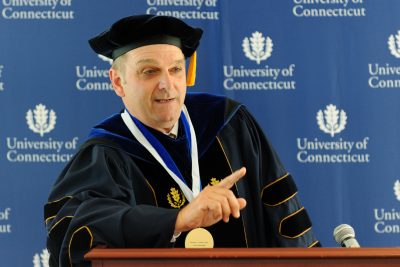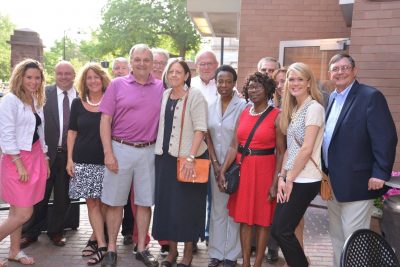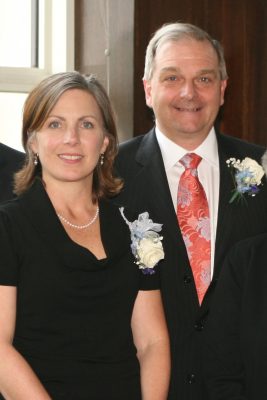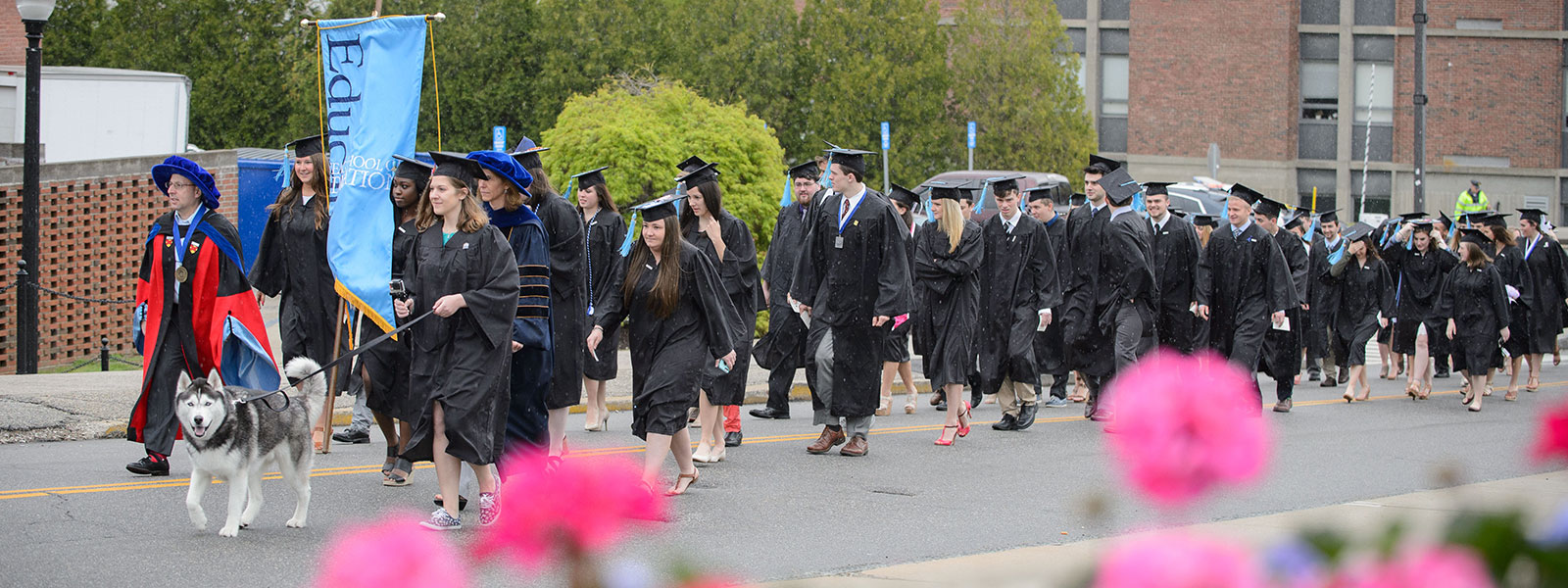Over the course of his time as dean — 14 years in total between 1997 and 2016 — Richard L. Schwab ’79 MA, ’81 Ph.D. has overseen a veritable transformation of the Neag School of Education. A community he affectionately refers to as his “second family,” the Neag School is one that Schwab, who stepped down as dean this past month to return to the faculty, has continually shaped for the better with every passing year.

For one, the Neag School has come to be widely recognized as a premier school of education in recent years, currently ranked by U.S. News & World Report as the No. 16 public graduate school of education in the United States. Four of its specialty programs are also ranked today among the top 20 nationally: Special Education, Educational Psychology, Secondary Teacher Education, and Educational Administration.
As the longest-serving dean in the Neag School’s history — and the only alum to have held the position — Schwab has directed the implementation of new University academic vision as well as a new academic vision for the Neag School; recruited a wealth of nationally and internationally renowned experts to its faculty; and seen numerous Neag School alumni and former mentees receive regional and national recognition for their leadership in the field. In 2014, Schwab also established the Dean’s Doctoral Scholars Program, through which the Neag School offers four years of financial support to a selection of promising Ph.D. candidates. This coming fall, the program will welcome its second cohort of scholars, all of whom are dedicated to pursuing research in one or more of the Neag School’s four strategic areas of focus — STEM education; creativity and innovation; educator quality and effectiveness; and social justice.
Perhaps most memorably, Schwab found himself at the helm when the School announced at the state Capitol in 1999 the largest gift ever given to a school of education in the country — $21 million donated by UConn alumnus Raymond Neag ’56, after whom the Neag School takes its name.
Serving as dean for a total of 14 years between 1997 and 2016, Richard L. Schwab is the longest-serving dean in the Neag School’s history — and the only alum to have held the position.
A Spirit of Giving
That spirit of giving seems to have followed Schwab throughout his years as dean. In addition to Raymond Neag’s unprecedented investment, the Neag School has received contributions of more than $17 million — and counting — over the course of Schwab’s tenure, the most money raised under any dean in the School’s history. Support for scholarships has increased dramatically over the course of his tenure as well. Whereas the Neag School awarded roughly $30,000 in scholarship support in 1998, the School today is providing upwards of $1.5 million in scholarship and fellowship aid to its undergraduate and graduate students.

It is precisely this kind of support that hits particularly close to home for the Neag Endowed Professor of Educational Leadership and former dean.
“I know from personal experience just how meaningful this kind of support is,” Schwab has said. His “second family,” he says, is responsible for providing him with the kind of invaluable opportunities that brought him to where he is today.
The first high school graduate in his family, Schwab himself received funding in the form of a graduate assistantship as part of the educational leadership program during the late ’70s and early ’80s — support that he is quick to credit with enabling him to pursue his chosen career path.
His commitment to education has not ceased in all the years since he was a student; Schwab has dedicated himself to service at the regional, national, and international levels, from serving as a National Commission on Teaching America’s Future commissioner and as a past president of the Council of Academic Deans for Research Education Institutions to working with universities around the world on educational reform issues.
Recognizing Richard Schwab
Colleagues and friends have been eager to pay tribute to Schwab’s years of service. This past spring, for instance, Neag School faculty and staff together contributed in honor of Schwab and Neag School associate deans Casey Cobb and Sandra Chafouleas an additional $3,200 to the Valerie J. Pichette Scholarship Fund — a scholarship that Schwab established this past fall in memory of his late longtime colleague, and which quickly amassed more than $61,000 from friends in and beyond the Neag School.
As three-time Neag School alumnus Desi Nesmith ’01, ’02, ’09 shared at this past year’s Undergraduate Commencement ceremony: “Dean Schwab has truly devoted himself to the Neag School. He has been integral to its success. He sincerely cares about its future. And now, as he concludes his final year as dean, we can look back and know that his superb leadership has, in large part, brought the Neag School to where it is today.”

The Neag School now invites you, too, to consider honoring Schwab’s longtime dedication to the field of education and to help advance the careers of Neag School students — whether through a gift to the fellowship fund established by Schwab and his wife, Kristin, or to another Neag School-affiliated fund.
Examples of funds established in support of the Neag School and its faculty and students include the following:
- Richard L. and Kristin E. Schwab Fellowship Fund — Established in 2009 to provide financial support in the form of a graduate assistantship to an incoming or continuing graduate student in the Neag School. This past spring, aspiring schoolteacher Alexandria “Lexi” Bodick ’16 (ED) was selected as the fund’s 2016-17 recipient. Give to the Richard L. and Kristin E. Schwab Fellowship Fund here.
- Helen M. Sherrod Memorial Scholarship — Established this past October by the Sherrod family to provide support for undergraduate students enrolled full time in the Neag School with demonstrated academic achievement and financial need. This memorial fund seeks to honor the legacy of the late Helen M. Sherrod, who served as a third-grade teacher in Bridgeport, Conn., for more than 25 years. The fund is intended to assist students interested in pursuing a degree in teaching at the university level, with the goal of raising $2,500 per year for each scholarship recipient. Contribute to the Helen M. Sherrod Memorial Scholarship here.
- Neag Alumni Society Endowed Scholarship — Established in 2014 by past and present members of the Neag Alumni Board as well as friends of the Neag School to provide financial support for a student enrolled in the Neag School. Give to the Neag Alumni Society Endowed Scholarship here.
- Valerie J. Pichette Scholarship Fund — Established in the fall of 2015 in memory of Valerie J. Pichette and her 30 years of service to the state of Connecticut, including her 18 years at the Neag School, where she served as an executive assistant — first with Dean Richard Schwab and later with former Dean Thomas DeFranco. Support a Neag School student with a gift to the Valerie J. Pichette Scholarship Fund.
Find additional Neag School giving opportunities here.


 Assistant professor
Assistant professor 
